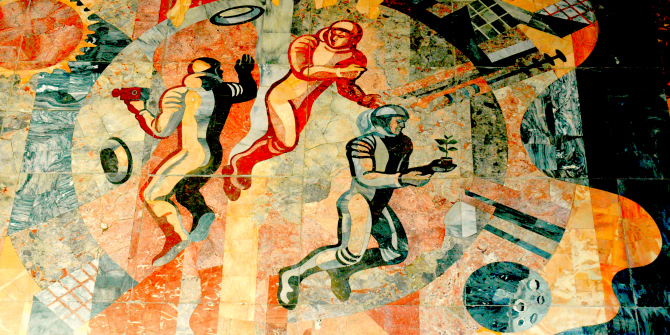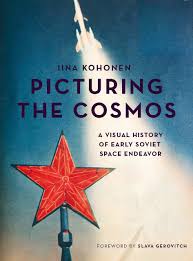In Picturing the Cosmos: A Visual History of Early Soviet Space Endeavor, Iina Kohonen examines a variety of artworks and archival materials to offer a visual history of the Soviet space programme. This beautifully illustrated book provides compelling insight into the construction of the cosmonauts as idealised heroes of the Soviet Union, finds Taylor R. Genovese, and shows the role that cosmic images played in the making of modernity.
Picturing the Cosmos: A Visual History of Early Soviet Space Endeavor. Iina Kohonen (trans. by Albion M. Butters and Tiina Hyytiainen). Intellect. 2017.
At the beginning of her book analysing the visual history of the Soviet space programme, Iina Kohonen introduces us to a photograph of Valentina Tereshkova, the first woman to fly in space. In the photograph, Tereshkova is kneeling in the grass; behind her looms a Vostok spacecraft tipped on its side. She is wearing a blue jumpsuit and is collecting papers and other scattered miscellanea, stuffing them into an open yellow bag. To her left is the discarded, crumpled form of an orange spacesuit tangled among the cords of a deployed parachute. Behind the spacecraft – and seemingly surrounding her – are a ring of people, mostly shoeless children, gazing in awe at the cosmonaut returned from space.
Kohonen’s Picturing the Cosmos: A Visual History of Early Soviet Space Endeavor uses Socialist Realist artwork as well as archival materials from the illustrated magazine Огонёк (Ogonyok) to make her arguments. She focuses on the role of cosmic images in the making of propaganda, the construction of modernity, the grounding of political and ideological principles as well as technoutopic imaginaries. However, the bulk of the book – and in my opinion, the most interesting – has to do with how the highly polished media in the Soviet Union constructed idealised heroes out of the cosmonauts.
Unlike the American portrayal of astronauts as exemplary individuals possessing a rare dose of The Right Stuff, Soviet media focused on the cosmonauts as a non-hierarchical group that trained in comradely harmony (106). Kohonen stresses that the media and visual arts of both the United States and the Soviet Union were a method of ideological warfare between the two Cold War superpowers: ‘Whereas the pilot heroes of the United States were lone rangers, Stalin’s pilots were seen as his own sons, the children of the common Soviet family’ (112). As such, Soviet media often released photos of Yuri Gagarin and other early cosmonauts engaged in the mundanities of everyday life at home: cooking, cleaning, going fishing, pushing a trapped car out of the mud. While American astronauts were exemplifying the rogue, rugged individual, Soviet cosmonauts were portrayed as the archetype of the strong, loving, community-orientated sons and daughters of the Motherland.
 Image Credit: Mural, Metro Kastrychnitskaja, Minsk, Belarus (american_rugbier CC BY SA 2.O)
Image Credit: Mural, Metro Kastrychnitskaja, Minsk, Belarus (american_rugbier CC BY SA 2.O)
And this leads to the biggest difference between the Soviet and American space programmes: the role of women. In the Soviet programme, women were recruited from the outset; in the United States, women did not enter the astronaut corps until the Class of 1978. Kohonen centres on Tereshkova and the complicated balance she had to strike while navigating the patriarchal reality of Nikita Khrushchev’s Soviet Union. In photographs, Tereshkova was presented as completely equal with male cosmonauts, smashing several cultural taboos, such as by wearing trousers and driving a car with her husband in the passenger seat. In reality, however, Kohonen writes that it was difficult for women to advance their professional lives: the burden of arranging childcare – on top of attending to their professional work – fell on women. Furthermore, inside the cosmonaut training centre itself, Tereshkova was relegated to performing so-called ‘women’s work’: for example, ‘on fishing trips the men caught the fish and Tereshkova cleaned and cooked them’ (117). Despite some advances in gender equality, photography and visual mediums were meticulously used by the Soviet media apparatus to advance ideological principles, even if those principles fell short in reality.
Indeed, Kohonen claims that ‘nothing was published by mistake and every detail left untouched was done on purpose’ (39). The most compelling example of this is in the case of Gagarin’s untied shoelaces. In the 1962 Soviet film The First Journey towards the Stars, chronicling Gagarin’s historic spaceflight, there is a moment when he descends from an airplane and walks a long expanse of red carpet toward Party leaders, including Khrushchev. However, after he emerges from behind an airline staircase, we can clearly see that Gagarin’s shoelaces are untied. Why would Soviet editors – trained and practised in meticulous reviewing and crafting of state media into ideologically pure deliverables – leave this detail in the frame? Why not crop to above his knee? While certainly the untied shoelaces were a mistake – a detail revealed by Gagarin in his autobiography – the fact that they were left in the film was not. Kohonen claims that ‘through the shoelaces, Gagarin’s humanity, ordinariness, and fallibility were emphasized’ (109).
Similarly, in the Soviet Union, the act of highly retouching – or heavily editing – an image was more about showing rather than eliminating a truth. Photographic erasure is a process that many from the United States and Europe associate with the Soviet Union but, due to George Orwell’s novels perhaps, it is also one that much of the Western population seems to misunderstand. The deliberate editing out of purged political members from official Party photographs was not an attempt to erase their memory or being, but rather to signal to the public that there had been a change in the political structure (83). This happened in the case of one famous photograph of Gagarin. The photo was cropped so that Gagarin became the only person in frame because cosmonaut Grigori Nelyubov – who was dropped from the space programme due to drunkenness and ‘bad behavior’ – could be seen in the background of the original (81). Nelyubov no longer lived up to the image of the idealised Soviet cosmonaut, therefore all traces of him were removed from the programme because the programme could only contain that romanticised model.
The sole gripes I have about the book are merely design choices – or perhaps they fall into the category of my own laziness. There is no index, so it becomes difficult to recall information from the text. Furthermore, the book is rich with beautiful photographs and paintings, but they are all placed in the centre of the volume, so as you are reading and Kohonen refers to certain figures, one must stop and flip back and forth between the text and images, which is highly disruptive when trying to engage with her excellent analyses – as well as some of her narrative twists and turns.
For example, in the conclusion, Kohonen reveals to us that the first photograph she introduced – of Tereshkova kneeling beside her spacecraft while onlookers watch her post-flight activities – may not be from her actual flight at all, but instead from a training exercise. The true provenance is inconclusive. However, the mystery of that photograph becomes the Soviet media in microcosm – blending the truth and hero construction so tightly that one is indistinguishable from the other.
Taylor R. Genovese is currently a doctoral student in Human and Social Dimensions of Science and Technology at Arizona State University. His academic interests include the anthropology of outer space, radical (techno)politics, human futures, social imaginaries, decolonization and extraterrestrial analogues. You can find out more about him and his research at taylorgenovese.com. You can also follow him on Twitter @trgenovese. Read more by Taylor R. Genovese.


 Find this book:
Find this book: 




